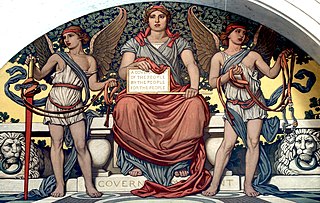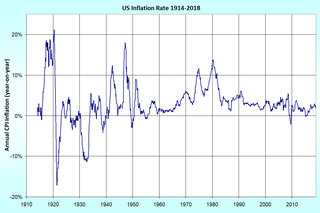
A central bank, reserve bank, or monetary authority is the institution that manages the currency, money supply, and interest rates of a state or formal monetary union, and oversees their commercial banking system. In contrast to a commercial bank, a central bank possesses a monopoly on increasing the monetary base in the state, and also generally controls the printing/coining of the national currency, which serves as the state's legal tender. A central bank also acts as a lender of last resort to the banking sector during times of financial crisis. Most central banks also have supervisory and regulatory powers to ensure the solvency of member institutions, to prevent bank runs, and to discourage reckless or fraudulent behavior by member banks.

In economics, inflation is a sustained increase in the general price level of goods and services in an economy over a period of time. When the general price level rises, each unit of currency buys fewer goods and services; consequently, inflation reflects a reduction in the purchasing power per unit of money – a loss of real value in the medium of exchange and unit of account within the economy. A chief measure of price inflation is the inflation rate, the annualized percentage change in a general price index, usually the consumer price index, over time. The opposite of inflation is deflation.

Currency substitution or dollarization is the use of a foreign currency in parallel to or instead of the domestic currency.

Monetary reform is any movement or theory that proposes a system of supplying money and financing the economy that is different from the current system.

Fractional-reserve banking is the common practice by commercial banks of accepting deposits, and making loans or investments, while holding reserves at least equal to a fraction of the bank's deposit liabilities. Reserves are held as currency in the bank, or as balances in the bank's accounts at the central bank. Fractional-reserve banking is the current form of banking practiced in most countries worldwide.
An open market operation (OMO) is an activity by a central bank to give liquidity in its currency to a bank or a group of banks. The central bank can either buy or sell government bonds in the open market or, in what is now mostly the preferred solution, enter into a repo or secured lending transaction with a commercial bank: the central bank gives the money as a deposit for a defined period and synchronously takes an eligible asset as collateral. A central bank uses OMO as the primary means of implementing monetary policy. The usual aim of open market operations is—aside from supplying commercial banks with liquidity and sometimes taking surplus liquidity from commercial banks—to manipulate the short-term interest rate and the supply of base money in an economy, and thus indirectly control the total money supply, in effect expanding money or contracting the money supply. This involves meeting the demand of base money at the target interest rate by buying and selling government securities, or other financial instruments. Monetary targets, such as inflation, interest rates, or exchange rates, are used to guide this implementation.
The reserve requirement is a central bank regulation employed by most, but not all, of the world's central banks, that sets the minimum amount of reserves that must be held by a commercial bank. The minimum reserve is generally determined by the central bank to be no less than a specified percentage of the amount of deposit liabilities the commercial bank owes to its customers. The commercial bank's reserves normally consist of cash owned by the bank and stored physically in the bank vault, plus the amount of the commercial bank's balance in that bank's account with the central bank.

The Bank of Korea is the central bank of the Republic of Korea and issuer of South Korean won. It was established on June 12, 1950 in Seoul, South Korea.
Money creation is the process by which the money supply of a country, or of an economic or monetary region, is increased. In most modern economies, most of the money supply is in the form of bank deposits. Central banks monitor the amount of money in the economy by measuring the so-called monetary aggregates.
Modern Monetary Theory is a heterodox macroeconomic theory that describes the currency as a public monopoly and unemployment as the evidence that a currency monopolist is restricting the supply of the financial assets needed to pay taxes and satisfy savings desires. MMT is seen as an evolution of Chartalism, and is sometimes referred to as Neo-Chartalism.

The Central Bank of Nigeria (CBN) is the Central bank and apex monetary authority of Nigeria established by the CBN Act of 1958 and commenced operations on July 1, 1959.
Monetary inflation is a sustained increase in the money supply of a country. Depending on many factors, especially public expectations, the fundamental state and development of the economy, and the transmission mechanism, it is likely to result in price inflation, which is usually just called "inflation", which is a rise in the general level of prices of goods and services.
Pushing on a string is a figure of speech for influence that is more effective in moving things in one direction than another – you can pull, but not push.
The credit channel mechanism of monetary policy describes the theory that a central bank's policy changes affect the amount of credit that banks issue to firms and consumers for purchases, which in turn affects the real economy.
The Sukhamoy Chakravarty Committee was formed in December 1982 under the chairmanship of Prof. Sukhamoy Chakroborty to assess the functioning of the Indian Monetary system. Its goal was to improve monetary regulation, a feat that was hoped would enable price stability. The committee, which submitted its report in April 1985, believed that price stability was essential for promoting growth and achieving other social objectives.
Credit control is an important tool used by Reserve Bank of India, a major weapon of the monetary policy used to control the demand and supply of money (liquidity) in the economy. Central Bank administers control over the credit that the commercial banks grant. Such a method is used by RBI to bring "Economic Development with Stability". It means that banks will not only control inflationary trends in the economy but also boost economic growth which would ultimately lead to increase in real national income stability. In view of its functions such as issuing notes and custodian of cash reserves, credit not being controlled by RBI would lead to Social and Economic instability in the country.
Monetary policy is the process by which the monetary authority of a country, generally the central bank, controls the supply of money in the economy by its control over interest rates in order to maintain price stability and achieve high economic growth. In India, the central monetary authority is the Reserve Bank of India (RBI). It is designed to maintain the price stability in the economy. Other objectives of the monetary policy of India, as stated by RBI, are:
Monetary policy concerns the actions of a central bank or other regulatory authorities adopt to manage and regulate currency and credit in order to achieve certain macroeconomic goals. The monetary policy of China aims to keep the value of the RMB stable and contribute to economic growth. "The Law on the People's Bank of China stipulates that the objective of monetary policy is to keep the value of RMB stable to contribute to economic growth."







